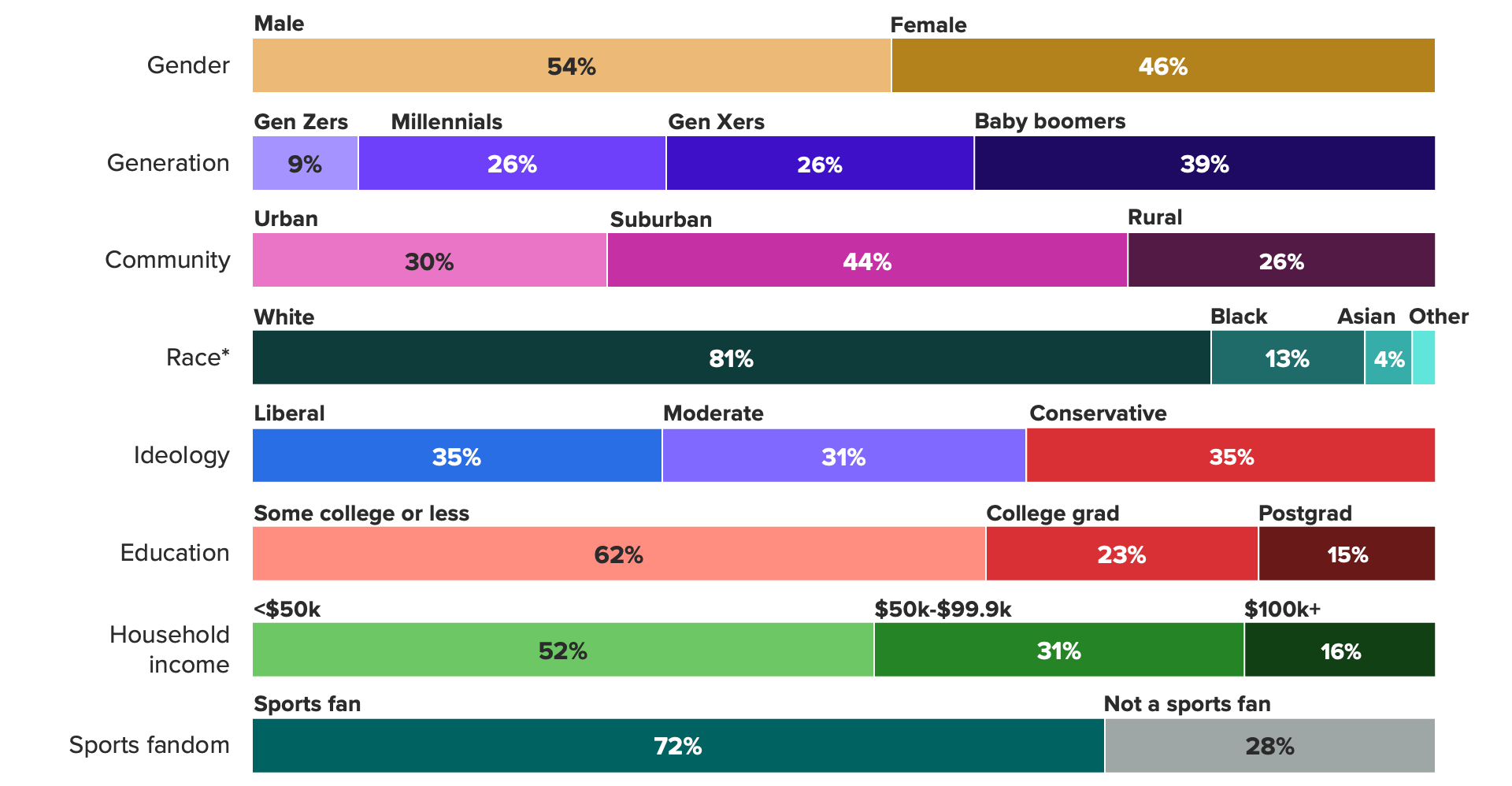Gen Z and Millennials Haven’t Completely Abandoned Linear TV — Yet

Key Takeaways
Linear TV’s reach extends far beyond older consumers who have no interest in digital media or other entertainment experiences.
In February, 27% of Gen Z adults and 34% of millennials said they watched linear TV daily, while 78% of adults who watched TV that often reported having at least one video streaming subscription.
Media companies can take advantage by creating more programming across linear, streaming and theatrical that all ties together.
For the latest entertainment industry news and analysis, sign up for our daily entertainment briefing here.
The entertainment industry has lamented the death of linear TV for years, but the truth is that U.S. consumers still spend a great deal of time watching traditional TV channels, and will likely continue to do so in the near future thanks to live programming.
While traditional TV’s life is limited — time spent with the medium is declining, and the average age of the medium’s viewers is rising — media and brand executives risk overlooking a still-important platform by myopically focusing on grim long-term pay TV prognostications. Morning Consult data shows that while the traditional TV audience is mostly made up of Gen Xers and baby boomers, it shouldn’t be ignored because pay TV still regularly reaches younger consumers, albeit to a lesser degree. Moreover, most linear TV viewers have at least one video streaming subscription, and many of them regularly make trips to the movies.
These habits indicate that media companies need to more effectively leverage their linear TV assets — by airing video streaming originals on traditional TV, for example, or developing television shows into theatrical IP. For brands, this means not pulling back spending on traditional TV too heavily, even as streaming rises.
Traditional TV draws older audiences, but many viewers are also interested in streaming and moviegoing
When imagining the linear TV audience, many picture older people who may lack tech savvy, or who show little interest in other entertainment experiences like moviegoing or playing video games. While the age expectation is in line with Morning Consult’s research — 65% of self-reported daily traditional TV viewers in February were Gen Xers or baby boomers — our data shows that a sizable share of younger viewers still watch linear TV. It also points to what other consumer types the legacy medium reaches.
For example, 35% of those who said they watched traditional TV daily in February were Gen Z adults or millennials. Meanwhile, identical shares of liberals and conservatives (35%) said they watched traditional TV daily. And 54% of daily TV viewers were male, while 62% don’t hold a college degree. Those who view traditional TV daily overwhelmingly considered themselves fans of sports (72%).

Despite skewing older, traditional TV still has incredible reach overall, as evidenced by the 41% of U.S. adults who watched it daily in February and the 62% who used it at all that month. This sheer scale explains why linear TV is still regularly reaching some Gen Zers and millennials, despite younger adults’ growing affinity for digital entertainment.
Over a quarter of Gen Z adults (27%) said they watched live TV daily in February via a cable or satellite TV subscription, while 34% of millennials said the same. Of course, these shares are lower than the comparable shares of Gen Xers (38%) and baby boomers (54%), but they’re nothing to scoff at, as they still represent sizable portions of younger consumers that brands might not already be reaching through digital media.
So while traditional TV is favored most by Gen Xers and baby boomers, the enduring massive scale of linear TV means brands, film studios and game companies should still be able to use it to supplement their reach among their target demographic. After all, Morning Consult data has shown previously that Gen Zers and millennials are more likely to be video streaming service subscribers and moviegoers relative to their older counterparts. Additionally, 78% of adults who watched linear TV daily in February have at least one video streaming subscription, while 40% of those watching TV that often went to the movies at least once that month.
Morning Consult data highlights the opportunity for media conglomerates to lean more heavily on TV shows for theatrical film IP, given how willing younger viewers of linear TV are to frequent cinemas. For example, Paramount’s “Yellowstone” accounted for six of the top 100 most-watched primetime broadcasts of 2022, hinting at the strong box office potential of a film based on the franchise.
But the fact that traditional TV is disproportionately favored by Gen Xers and baby boomers can also be a positive for media companies looking to boost streaming viewership. Media giants should use traditional platforms to expose Gen Xers and baby boomers to marquee streaming programming that they might not otherwise be aware of due to their devotion to pay TV. Disney has embraced this strategy with “Andor” and “The Mandalorian” before that, and will start airing episodes of the Hulu original “How I Met Your Father” on its Freeform cable channel next month.
How linear TV programming could change as companies chase profits for streaming operations
While cross-pollination of the same IP across linear and streaming can boost programs’ ultimate ad revenue and reach, this would also stoke consumer demand. In March, 55% of all adults who watched linear TV in the past month said they are very or somewhat interested in seeing original programming from video streaming services on traditional TV channels, while the comparable shares of all other generations were close to 50% or higher.
This is why we argued in our January State of Media and Entertainment report that companies should lean more on platforms like linear TV to better monetize streaming content, and it’s also why it made sense that Disney’s Bob Iger in February hinted at doing this.
Iger, along with the rest of Hollywood, has an intensified mission to maximize the return on programming spend amid macroeconomic pressures. This focus on efficient content spending may eventually lead to a traditional TV landscape that has more channels playing fewer unique programs. For example, while MTV’s seemingly exclusive reliance on “Ridiculousness” has drawn criticism for being an unimaginative cash grab, Paramount’s media networks chief Chris McCarthy said in a recent interview that the strategy “absolutely delivers” for the linear TV audience, which according to him favors going to channels for one type of show.
And while the average viewer can only digest so much “Ridiculousness,” Morning Consult data shows there is demand on linear TV for networks anchored around a single hit show. In March, 54% of all adults who watched linear TV in the past month said they would prefer if there were more channels centered around reruns of just one or a few popular titles.
The key, as with all else in the media business, is to capitalize on these consumer trends without overdoing it. While our data suggests there’s room for more traditional TV networks to trim their programming slates in favor of fewer hits, going all-in on this strategy would likely drive some viewers away from traditional TV. Moreover, media companies can’t run entire seasons of all their marquee streaming service originals on their traditional TV networks, as this would undercut the value of paying for video streaming subscriptions.
Although consumption of linear TV is still robust, it will only decline in reach in the years ahead, particularly among younger consumers — meaning its ability to act as an accelerant to streaming and box office revenue will steadily deteriorate, too. Companies should consider the guidance above to maximize their benefits from the traditional medium while it’s still reaching over 40% of adults daily.
Kevin Tran previously worked at Morning Consult as the senior media & entertainment analyst.